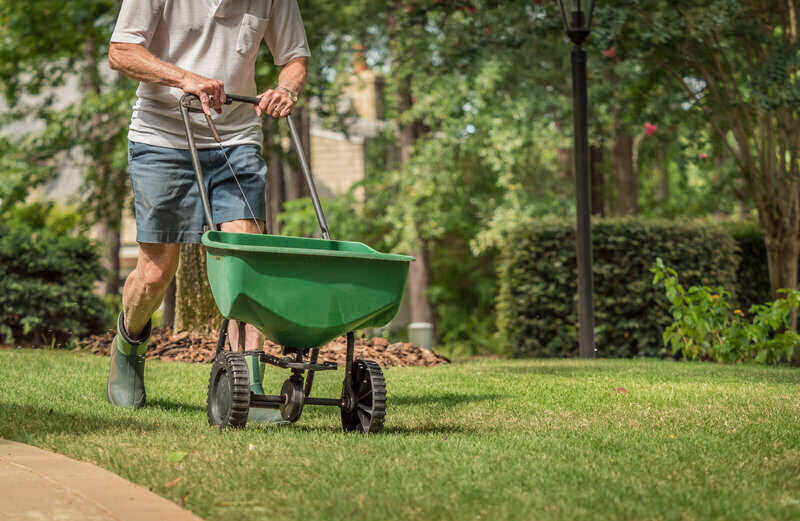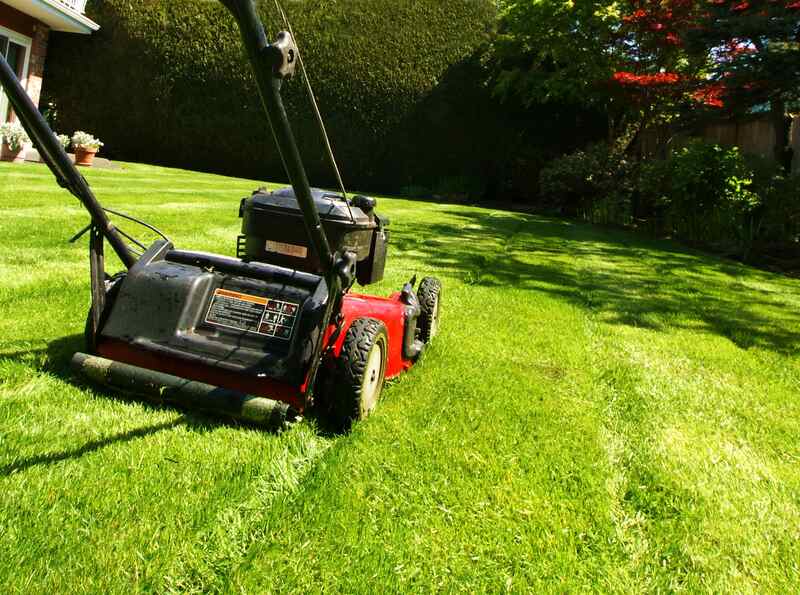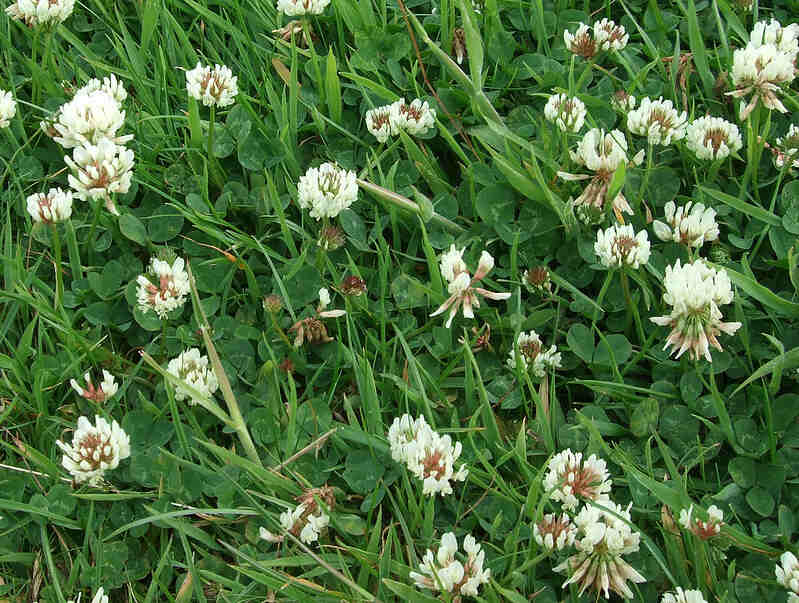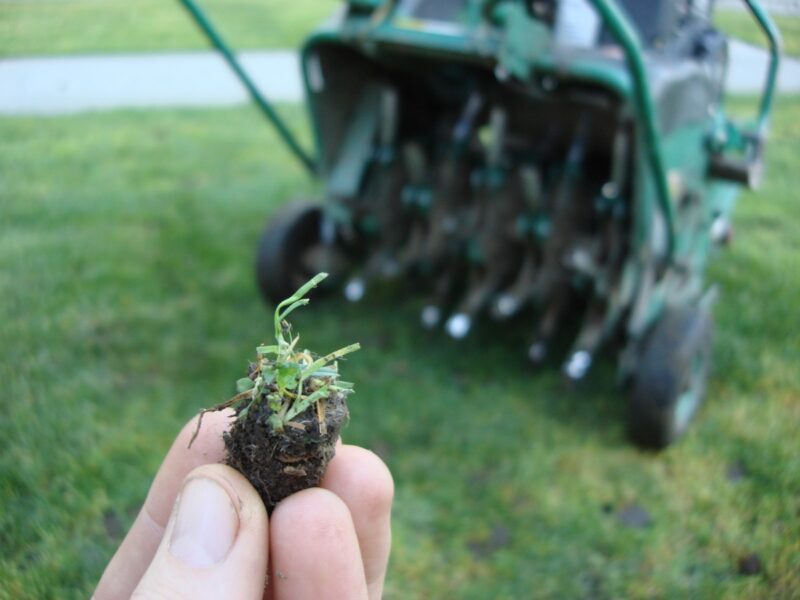
A lot goes into keeping your Iowa lawn looking nice: mowing, fertilizing, weed control, disease prevention, insect control, aeration, and even seeding. It can be challenging to keep it straight in your head when you’re supposed to do each of these things. To help, we’ve put together an Iowa lawn care schedule that will get you through the growing season.
Basic Lawn Care Schedule for Iowa

Break your lawn care maintenance tasks into easy-to-follow blocks based on the season.
Spring Lawn Care Tasks
- Apply pre-emergent herbicide
- Begin mowing
- Apply early-season fertilizer to cool-season grasses
- Aerate
- Seed warm-season grasses
- Begin preventative fungicide applications
Summer Lawn Care Tasks
- Continue mowing
- Fertilize warm-season grasses
- Apply preventative grub control
- Spot-treat weeds
- Apply curative fungicides and insecticides
Fall Lawn Care Tasks
- Fertilize cool-season grasses
- Spot-treat weeds
- Apply curative fungicides and insecticides
- Seed cool-season grasses
- Mow until grass goes dormant
Mowing in Iowa

Mowing is one of the most important lawn maintenance tasks and something you will do across all three seasons.
Spring Mowing
Start mowing when your lawn reaches three inches tall. The exact date will depend on your turfgrass type.
- Warm-season grasses come out of winter dormancy and start growing when soil temperatures are above 50 degrees Fahrenheit.
- Cool-season grasses start growing when air temperatures climb above 40 degrees Fahrenheit.
Remember, never cut more than one-third of the grass blade each time you mow, and always mow to the recommended mowing height for the species.
Summer Mowing
As the summer heat settles in, grass growth changes.
Most turfgrasses grow well at a height of two inches. This height controls weeds and helps the grass tolerate hot temperatures and drought. Mow frequently to keep your grass under three inches tall.
- Mow warm-season grass once a week or more, depending on growth.
- Cool-season grasses grow slowly when it gets hot. You may need to mow every two to three weeks to keep it from getting too long.
Fall Mowing
At this point, all grass types will start getting ready for winter, and their growth will slow and then halt. However, cool-season lawns typically have one more growth spurt now that the temperatures are dropping. They’ll grow faster for a while, requiring regular mowing.
Warm-season lawns will enter winter dormancy much earlier than cool-season grass types. You’ll need to mow them until temperatures drop into the low 60s.
Lawn Fertilization Schedule for Iowa Lawns
Many warm-season grasses need to be fertilized three to four times a year to promote a healthy lawn, and many cool-season lawns need to be fertilized two to three times a year. Specific rates depend on your lawn needs and soil fertility.
In general:
- Kentucky Bluegrass: Fertilize in the spring, mid-September, and late October. Apply one to five pounds of nitrogen (N) fertilizer per 1,000 square feet of lawn yearly.
- Perennial Ryegrass: Fertilize in the spring, mid-September, and late October. Apply four pounds of nitrogen (N) per 1,000 square feet yearly.
- Tall Fescue: Fertilize in mid-September and late October. Fertilize in the spring if needed. Apply one to four pounds of nitrogen (N) per 1,000 square feet of lawn per year.
- Bermudagrass: Fertilize every six weeks from May to August. Apply two to four pounds of nitrogen (N) per 1,000 square feet of lawn yearly.
- Zoysiagrass: Fertilize every six weeks from May to August. Apply one to two pounds of nitrogen (N) per 1,000 square feet of lawn yearly.
- Buffalograss: Fertilize every six weeks from May to August. Apply one to two pounds of nitrogen (N) per 1,000 square feet of lawn yearly.
Pro tip: Do not apply more than one pound of nitrogen per 1,000 square feet per application.
Weed Control Schedule

Lawn weeds drive homeowners crazy and are almost impossible to control if you ignore them. Apply a pre-emergent herbicide in the early spring, followed by spot treatments with post-emergent herbicide as needed.
Pre-emergent herbicides prevent germinated seedlings from establishing in your yard, limiting your weed problem from the start. They are especially helpful in controlling annual crabgrass and dandelions.
Apply pre-emergent products in the spring after five days of temperatures between 50 to 55 degrees Fahrenheit. In Iowa, this typically happens in late March or the beginning of April.
Post-emergent herbicides target actively growing weeds. Most products target non-grassy or broadleaf weeds, making them safe for your grass. For identification tips, check out this article about Iowa weeds.
Pro tip: A good rule of thumb is to put your pre-emergent down once the dogwoods and forsythia bushes bloom.
Disease Prevention
Lawn diseases are time-consuming and challenging to treat, and they can quickly damage your beautiful turf. Prevention is the key to a healthy lawn. Common lawn diseases in Iowa include:
- Brown patch
- Dollar spot
- Anthracnose
- Red thread
- Fairy ring
- Rust
- Snow mold
- Leaf spot
- Necrotic ring spot
Most often, lawn diseases in Iowa are fungal. Problems arise in the late spring, last through the summer, and sometimes, even into the fall. Apply a preventative fungicide in the late spring and reapply every two to four weeks until the late summer.
Pro tip: Rotate fungicides to prevent resistance.
Insect Control
Like weed control, combination therapy controls insects, including preventative and curative methods. The main pest wreaking havoc on lawns in the Hawkeye State is white grubs. Use a preventative insecticide to control white grubs and treat other insects if they become problematic with selective products.
Check your lawn for signs of an infestation. If you see any issues, begin treatment immediately to keep it from becoming a big problem.
Pro tip: For help identifying lawn insects and choosing the suitable insecticide, contact your local county extension office.
White Grub Control
Lawn grubs are one of the biggest fears of Iowa homeowners. These off-white worms are the immature larvae of scarab beetles. They have brown heads and chubby bodies. Once in your lawn, they feed under the soil’s surface, eating the tops of your grassroots. Their feeding creates irregular patches of dead grass and can destroy your lawn if left untreated.
There are a couple of approaches to grub management. You can be proactive and put a preventative down, treat an active infestation, or you can do nothing and repair your damaged lawn.
- Prevention: Apply grub prevention containing clothianidin, chlorantraniliprole, imidacloprid, or thiamethoxam in June or July (most people do it around the 4th of July because it’s easy to remember). Apply chlorantraniliprole-based products in April or May.
- Control: Apply grub killers when you see grub activity and damage.
Populations vary significantly from year to year, so it’s hard to predict whether they’ll be problematic. Application timing is critical for preventative grub control. They only control grub eggs and young larvae, so getting them down right before or as the eggs hatch is essential. If you apply them too early, the active compounds may be ineffective.
Aerating an Iowa Lawn

Your aeration schedule depends on your grass type and aeration method.
Core aerate when your grass is actively growing. This helps recovery and promotes root growth.
- Aerate cool-season grass in the late spring or early fall.
- For warm-season grass, aerate in the early to mid-summer
Spike aerating is a little more forgiving. You can do it anytime, but it’s best to do it when grass growth is at its peak. In other words, follow the same schedule as core aeration.
Pro tip: For more information, check out our guide on aerating your Iowa lawn.
The Best Time to Seed an Iowa Lawn
You might be picking up on a theme when it comes to lawn care–many practices relate to the growing season. Seeding your Iowa lawn is the same, whether starting a new lawn from scratch or overseeding bare spots.
Spread the seed before the active growing season This gives seeds time to germinate. The new sprouts will also hit that peak growth period and take off. When temperatures start to cool down in the fall, you’ll have a well-established patch of new grass with a solid root system.
- Seed cool-season grasses between August and October. Try to give them at least six weeks of growth before the first fall frost.
- Seed warm-season turfgrasses between April and June. This timing gives them about a month to germinate and start growing before summer temperatures trigger growth.
You can also seed cool-season grass in the spring. Seeds will still germinate in the spring, but young grass will grow better if it goes into winter dormancy after sprouting versus summer dormancy.
FAQ About Iowa Lawn Care
How many times do you mow in Iowa?
Mowing frequency depends on the temperature and how quickly your grass is growing. In the spring and fall, when cool-season grasses are growing, you may need to mow every four to five days. When temperatures are hot during the summer, cool-season lawns will slow their growth and might only need mowing every seven to 10 days. Warm-season grass types typically need to be mowed about once a week.
When is the best time to fertilize a lawn in Iowa?
The most important times to fertilize cool-season turfgrasses like Kentucky bluegrass and perennial ryegrass are about mid-September to help recover from summer stress and then again in late October to prepare for winter dormancy. You can also fertilize cool-season lawns in the spring to give them a boost as the growing season starts.
Warm-season lawns need more regular fertilizing and should be fed every six weeks from May to August.
How do I take care of my Iowa lawn?
To keep your Iowa lawn looking lush and beautiful, it needs regular mowing, fertilization, and weed control. You’ll also want to regularly scout for diseases and insects, treating any problems that arise. Aeration may be needed if there is soil compaction, and overseeding if bare spots arise.
Need Help With Your Iowa Lawn Care?
There’s no denying that it takes a lot of time and work to keep your Iowa lawn looking its best. Whether you’re short on time or just looking for someone to do the lawn maintenance for you, let LawnStarter connect you with a local landscaping team that will help make your yard the best it can be.
Main Photo Credit: NNehring / Canva Pro / License
Editorial Contributors
-

Amanda Shiffler
Author
Most comfortable with soil under her fingernails, Amanda has an enthusiasm for gardening, agriculture, and all things plant-related. With a master's degree in agriculture and more than a decade of experience gardening and tending to her lawn, she combines her plant knowledge and knack for writing to share what she knows and loves.
Learn more -

Kimberly Magerl
Editor
Kimberly Magerl is a writer and editor specializing in landscaping, gardening, lawn care, and pest control. She enjoys growing orchids, tending to fruits and vegetables in her garden, and cooking with her home-grown herbs.
Learn more